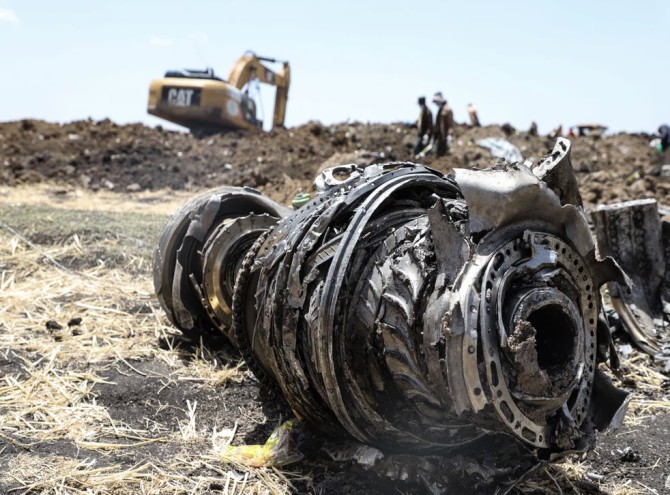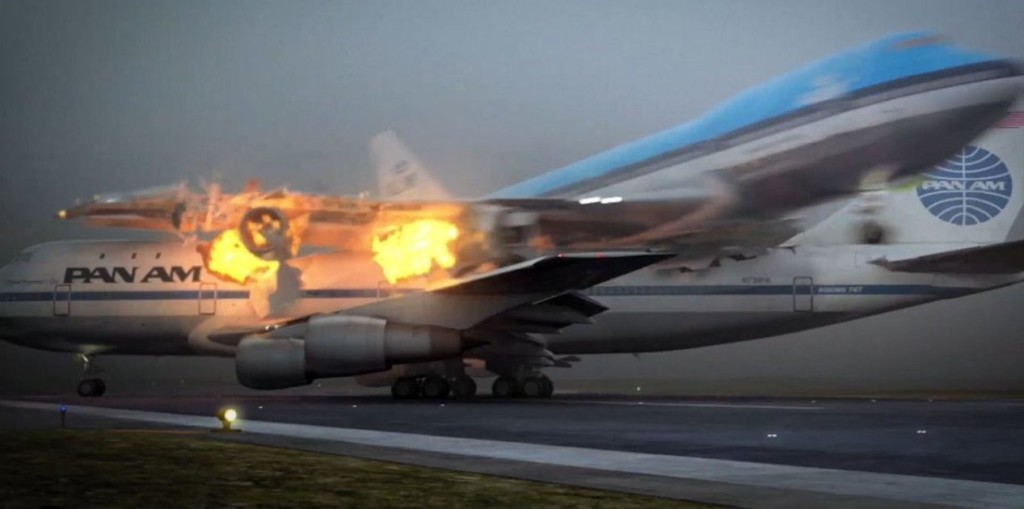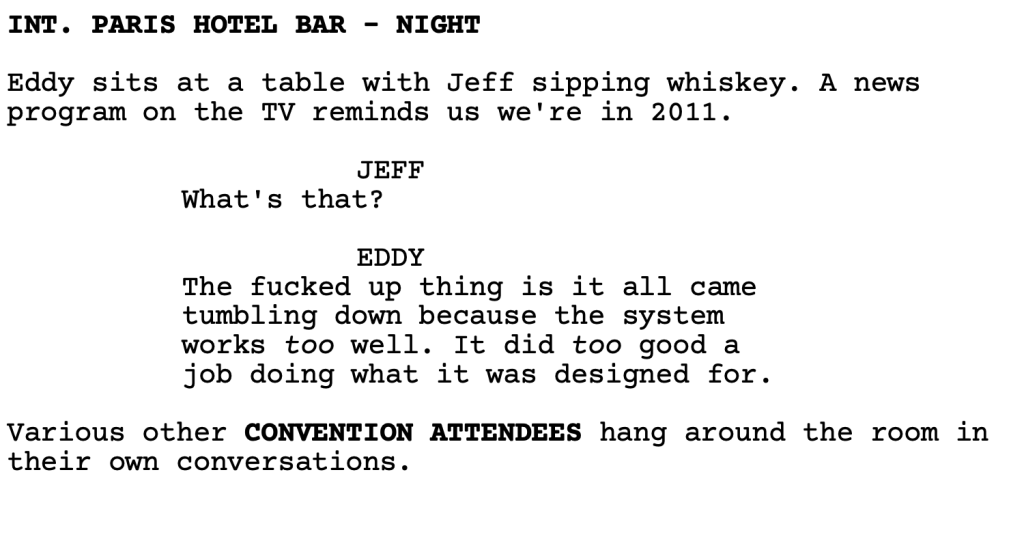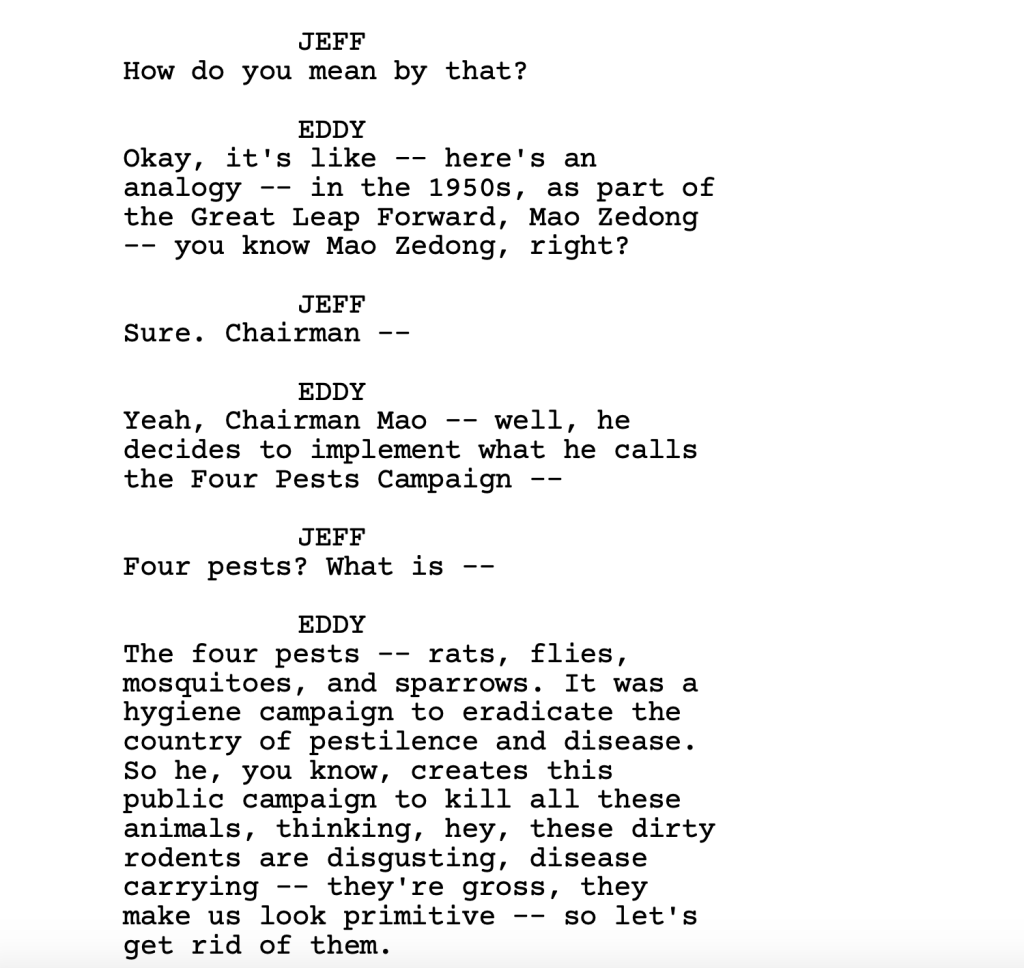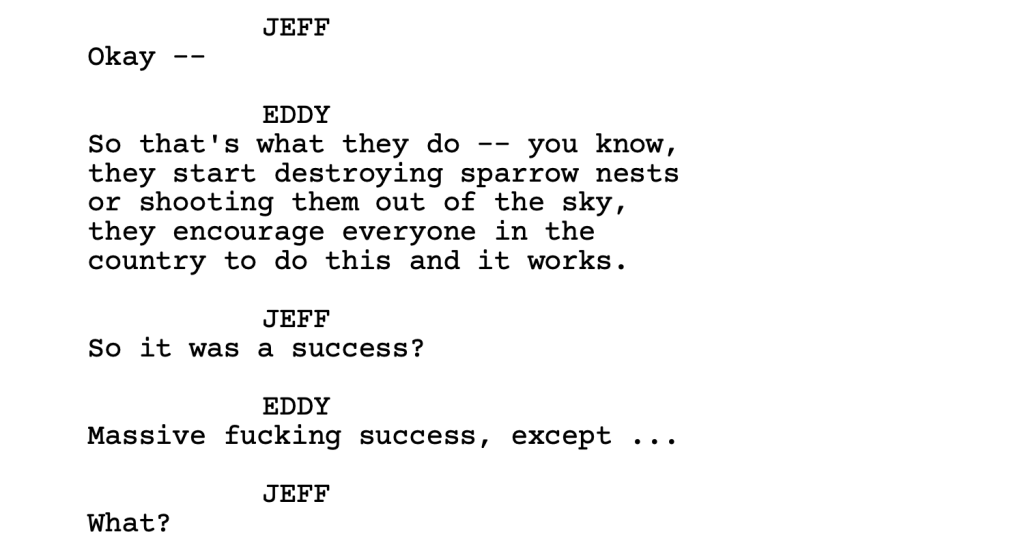Today, we learn the vital difference between a STORY and a STORYTELLER.
Genre: Drama/True Story
Premise: Journalists race to expose how Boeing knowingly misled regulators, pilots, and airlines to cover up a problematic flight software system on the 737 MAX, leading to two major airplane crashes and the deaths of 346 people. Based on real events.
About: Today’s script comes from an up and coming writer and producer, Terry Huang. This script made last year’s Black List with 9 votes.
Writer: Terry Huang
Details: 105 pages
I used to be terrrrrriiiiffieeed of flying. To the point where, every time I got on a plane, I accepted that it was the end of my life. No, seriously. I’d look back fondly at the things that I’d accomplished. I’d be frustrated at the things that I hadn’t. And then, off I’d go, onto this 200 foot long metal tube that was sure to crash down in a fiery blaze with me inside of it. It was fun while it lasted!
It isn’t difficult to figure out where my fear of flying originated. When I was 8 years old, waiting at the terminal for a red eye flight to a Mexican destination with my family, my mother staged an open resistance to getting on the plane because she had a “feeling” that there was something wrong with it and that it was “going to crash.” Up until that point, I didn’t even know planes could crash! And so my fear of flying began.
The good news is I’m over that fear. Now I just worry about there being enough space for my bag in the overhead.
But due to my history, I’m still fascinated by airplane disasters. I still investigate famous crashes all the time. I’ve probably spent upwards of 30 hours looking into the infamous Tenerife crash (the most deadly crash in aviation history). It’s why I’ve repeatedly mentioned on this site that I’m looking for a killer plane concept to produce (have one? Send me the logline!).
Today’s script covers one of the scariest airplane disaster concepts of all, one that involves pilots doing exactly what they’ve been trained to do, only to have the plane’s computer take over and kill them. Let’s take a look.
60-something Dominic Gates is a reporter for the Seattle Times. In October of 2018, he hears about a Lion Air plane crash in Indonesia that killed all 189 people on board. Specializing in airplane crashes, Dominic starts making calls to his contacts to find out what happened.
Meanwhile, halfway across the country, in the Bloomberg news offices in New York, reporters Peter Robison and Joel Weber also hear about the crash. The plane that went down is something called a 737Max, which is a modified 737 with bigger engines. They immediately call Boeing, who manufactured the plane, to see if they’ve made a statement yet. They haven’t.
We then hop over to Paris, where plane supply salesmen, and long time buddies, Eddy Knowles and Jeff Spalding, are attending the annual airline industry’s trade show, a place where all the big players, including Boeing and Airbus, are getting ready to promote their latest planes and technologies. Their conversation revolves around the fact that Boeing’s game-changer plane, the Dreamliner, is more like the Nightmareliner, as they can’t get the thing approved to fly. As a result, Boeing’s been forced to improvise, adjusting planes that have already been approved, which has resulted in the 737Max.
We follow the bouncing ball all over the world as we meet people on every side of the issue, from journalists, to pilots, to mechanics, to the CEOs of the major plane companies themselves, all of which heats up when a SECOND 737Max crashes in Addis Ababa, Ethiopia. What Dominic, Joel, and Mike eventually find out is that when Boeing added bigger engines to the Max, it required them to also add a software system that adjusted the balance of the plane. That software erroneously took over and sent both planes plunging to their demise.
But the real scandal occurred behind the scenes where Boeing deliberately hid mention of this software system in their plane manuals. You may say, “Why would they do that?” It was because the FAA mandated that any significant change in the operation of a plane require training. Training cost money so airlines hated it. Since Boeing knew the airlines wouldn’t buy any planes if significant training was required, they hid the software from the airlines, figuring it would work in the background and therefore no pilots would ever need to know about it. The script concludes by informing us that because Boeing is so important to the economy, the company got off with a mere slap on the wrist for their gross negligence.
As a screenwriter, you are a shaper.
You know the famous scene in Ghost where Patrick Swayze and Demi Moore take a lump of wet clay and slowly mold it into a vase? That’s what you’re doing as a screenwriter. You’re taking a lump (all these ideas in your head) and you’re molding it into a vase (a thoughtful compelling story).
When you don’t do that and you just sort of vomit everything onto the page – throwing clay around willy-nilly, not looking at your creation, checking your phone for messages, flicking the specks of clay on your hands back onto the lump – sure, you’re technically still creating a vase. But there’s no shape to it. It’s just a bunch of clay.
I want you to internalize what I’m about to tell you because it’s important:
Anybody can tell a story. The writer differentiates themselves by being a storyTELLER.
I can get the homeless guy down the street to ramble on for 3 hours about how the bus driver wouldn’t drop him off at his favorite liquor store. That will technically be a “story.” But it’s not a story told well. That’s what the storyteller’s job is. To take all the variables and shape them in a way that the story has form, dramatic value, and purpose.
Otherwise you’re just giving us information. That’s how Single Point of Failure read. We just go from room to room, character to character, telling us new things about the plane crashes. There’s no form to it.
A good example of a screenplay that has form and is somewhat similar to Single Point of Failure is Margin Call. That script is about a giant investment bank that realizes it has a ticking time bomb in its investment software that has a high probability of bringing the entire bank down if they don’t do something about it immediately.
Now you could’ve written Margin Call like you wrote Single Point Of Failure, where we meet all these different players across New York City. A rival bank’s CEO, someone at the SEC, a couple of reporters who get wind of what’s going on and start digging into their story. But anybody can write that. There’s no storytelling to that version.
Instead, writer J.C. Chandor cleverly focuses on a low-level worker in the company who discovers the error. He realizes that they’ve got about 24 hours before this destroys the company. So he brings it to his middle-manager boss. The middle manager then brings it to his boss. That boss then brings it to his boss. Until the climax is them in a meeting with the head of the company. The story has a clear design to it that’s been carefully shaped.
Meanwhile, Single Point of Failure feels like its scenes were generated in a randomizer. I always get nervous when every scene introduces a new character, which this does. That tells me that the writer isn’t thinking his story through. You’ve got all of these characters you’ve already created. Why not craft a story around them as opposed to throwing new character after new character at us? It’s because coming up with a story is harder. And we’re all inherently lazy and prefer to take the path of least resistance. But if you want to be a good screenwriter, that’s what you have to do.
But guess what?
I still liked Single Point of Failure.
A lot of that is because I like getting into the nitty gritty of why airplane crashes happen. So this whole script was basically catnip to me. And I was rewarded for my curiosity. I learned some things – such as Boeing deliberately hiding the 737 Max software in their manuals – that I didn’t know before.
Also, one of the necessary ingredients of a true story like this is that it makes you mad. If you’re mad, it means you’re emotionally invested. And while I’d rather be happy at the end of a movie than mad, I’d also rather be mad than have no feelings whatsoever. And this story makes you mad. You can’t believe that a corporation this big with this much responsibility would do something that put so many people in danger. It’s infuriating.
A Single Point of Failure is a plane crash geek’s version of Spotlight. If that sounds like something you’d be interested in, check it out!
[ ] What the hell did I just read?
[ ] wasn’t for me
[x] worth the read
[ ] impressive
[ ] genius
What I learned: I’m going to give you at least one scene of good dialogue in your next screenplay. It’s called doggy bag dialogue. Doggy bag dialogue is any interesting piece of information relevant to the scene or broader story that the reader can take home with them. Single Point of Failure has a good one. This doggy bag dialogue occurs when Eddy explains to Jeff why Boeing’s MCAS system actually works *too* well.

